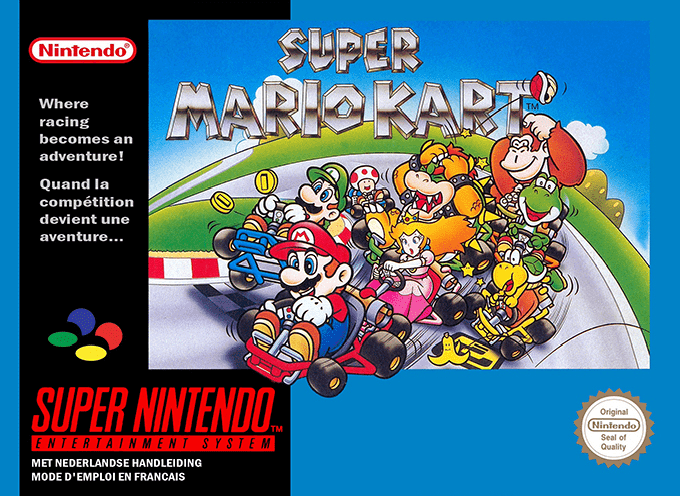
SUPER MARIO KART
Super Mario Kart, released for the SNES in 1992 by Nintendo, is a groundbreaking kart-racing game that introduced a new genre and set a gold standard for multiplayer gaming. Combining competitive racing with a whimsical Mario-inspired aesthetic, it blends technical innovation and engaging gameplay into an unforgettable experience.
The visual presentation of Super Mario Kart is built around the SNES’s Mode 7 graphics technology, which allows for the scaling and rotation of backgrounds to create the illusion of a 3D racetrack. This innovation gives each track depth and motion, immersing players in vibrant courses inspired by the Mario universe. From the lush green fields of Donut Plains to the lava-filled Bowser’s Castle and the treacherous Rainbow Road, every track has a distinct visual identity, brought to life with colorful environments and animated details like bubbling magma and shimmering road effects.
The character sprites, featuring Mario, Luigi, Peach, Bowser, and other beloved characters, are expressive and detailed, matching their personalities. Each racer’s kart is rendered with smooth animations, whether they’re accelerating, drifting, or recovering from a banana peel. The game’s item effects, such as the spinning shells and the bursts of stars, are visually dynamic, adding to the sense of action and chaos on the track.
Super Mario Kart’s gameplay is equally innovative, combining tight controls with a unique balance of skill and strategy. The handling of the karts is precise, with subtle differences between characters that encourage experimentation. Power-ups, collected from item boxes scattered across the tracks, introduce an element of unpredictability, ensuring that no race is ever decided too early. The strategic use of items, from red shells to lightning bolts, can turn the tide of a race, fostering both excitement and tension.
The game supports both single-player and multiplayer modes. The single-player Grand Prix offers escalating challenges across the cup series, while the multiplayer mode includes competitive racing and the iconic Battle Mode. Battle Mode, set in specially designed arenas, emphasizes head-to-head strategy as players use items to pop their opponent’s balloons. This mode adds depth and variety to the gameplay, cementing Super Mario Kart as a social gaming classic.
The audio design of Super Mario Kart is integral to its charm. Composed by Soyo Oka, the soundtrack features upbeat and catchy themes that perfectly match the high-energy racing action. Each track’s music reflects its setting, from the cheerful tunes of Mario Circuit to the eerie, atmospheric notes of Ghost Valley. The sound effects, from the revving of engines to the satisfying crack of a green shell hitting its target, enhance the immersion and excitement.
Super Mario Kart’s impact extends far beyond its technical achievements. Its unique blend of competitive and casual gameplay, paired with its vibrant art and engaging music, created a formula that remains influential in gaming. It introduced the concept of kart racing as a genre and established the Mario Kart series as a cornerstone of multiplayer gaming.
In conclusion, Super Mario Kart on the SNES is a timeless classic that combines innovation, artistry, and sheer fun. Its Mode 7 graphics, dynamic gameplay, and enduring appeal make it a standout title in the SNES library and a landmark in gaming history.

